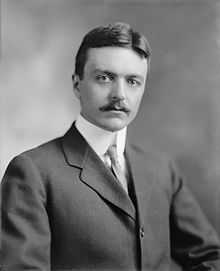Lathrop Brown

Lathrop Brown (February 26, 1883 – November 28, 1959) was a United States Representative from New York. Born in New York City, he graduated from Groton School in 1900 and from Harvard University in 1903, where he was roommates with Franklin Delano Roosevelt. He engaged in the real estate business and served in Squadron A of the National Guard of New York, for five years. He was elected as a Democrat to the Sixty-third Congress (March 4, 1913 to March 3, 1915) and unsuccessfully contested the election of Frederick C. Hicks to the Sixty-fourth Congress. He was special assistant to the Secretary of the Interior from March 1917 to October 1918, and served as a private in the Tank Corps during the First World War. He was joint secretary of President Woodrow Wilson's Industrial Conference in 1919 and was a delegate to the Democratic National Conventions in 1920, 1924, and 1936. He studied monetary theory at the Graduate School of Harvard University from 1928 to 1932, afterwards moving to California's Big Sur, settling on a cattle ranch which later became Julia Pfeiffer Burns State Park. He was elected to the sheriff's posse of Monterey County in 1947 and was a member of committee to supervise the Graduate School of Public Administration of Harvard University in 1954 and 1955. He died in Fort Myers, Florida and was cremated; the ashes were interred in Abbey of the Light, Manasota Memorial Park, Sarasota, Florida. His home at Nissequogue, New York, known as Land of Clover, was added to the National Register of Historic Places in 1993.[1]
References
- ↑ "National Register Information System". National Register of Historic Places. National Park Service. 2009-03-13.
| United States House of Representatives | ||
|---|---|---|
| Preceded by Martin W. Littleton |
Member of the U.S. House of Representatives from New York's 1st congressional district 1913-1915 |
Succeeded by Frederick C. Hicks |